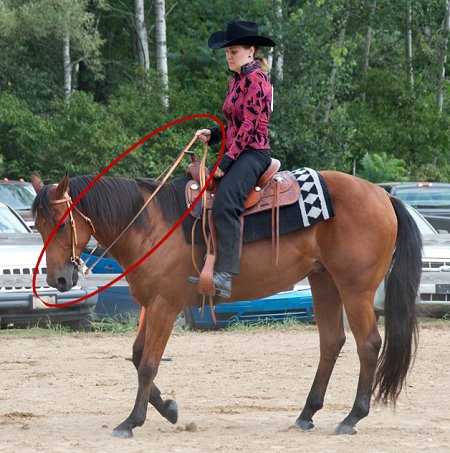Signal is defined as the time it takes between the rider picking up on the reins and the bit or shank engaging the horse’s mouth.
Handling occurs after the signal: When the bit is actively engaged in the mouth.
The rider below is already “handling” the horse’s face (see that the reins are tight and the bit is engaged) after first picking up on the reins to signal the horse that a request was coming.
A horse should be able to feel you pick up the reins before the bit does anything. The cue prepares him to act. (See also Anticipation)

In the case of a simple O-ring snaffle bit, the ring will rotate slightly (the signal), giving a horse an indication that his rider intends to “handle” him using bit pressure, which he would like to avoid. The “signal” of this bit is better than with a more fixed bit.
If the shanks of a curb-action bit are adjusted at a proper angle (usually about 45 degrees), the horse will have time to realize that the shank is moving and prepare for a leg or body cue before the curb is actually engaged. If properly trained, he will anticipate the request, and only a very light cue will suffice to direct his movement.
A bit with a looser curb and a longer shank will have a longer “signal” time. Additionally, when a bit is balanced so that its rein loops hang a little forward of center when not engaged by the reins, it takes just that fraction of a second longer for the reins to take up the slack, which lengthens the signal time. A bit balanced this way is an advantage for quick release of pressure and reliable neutral position. When the reins are dropped, the bit immediately swings forward to its balanced position and releases the pressure. (see Release Training)
A novice or inexperienced trainer needs to give a horse as much “signal” as possible. Parelli recommends that trainers use a light-weight extension from the reins to the bit (slobber straps or a light-line of about 6″ length), which extends the amount of slack that has to be taken up before actual pressure on the bit (lengthening signal time) and ensuring that the bit is released at the quickest possible moment.
A short signal time is to be used only by the most experienced riders.
Horse training and equestrian activities in general can be dangerous. While we try to present relevant and valuable content, under no circumstances does horse-pros.com or its members or contributors take any responsibility for the well-being of any horse or person using a method outlined here.
We certainly don’t know everything. Please share your expertise and experiences. Comment on what is already written or Suggest a Category and Educate us about it. Grow Horse-Pros.com©